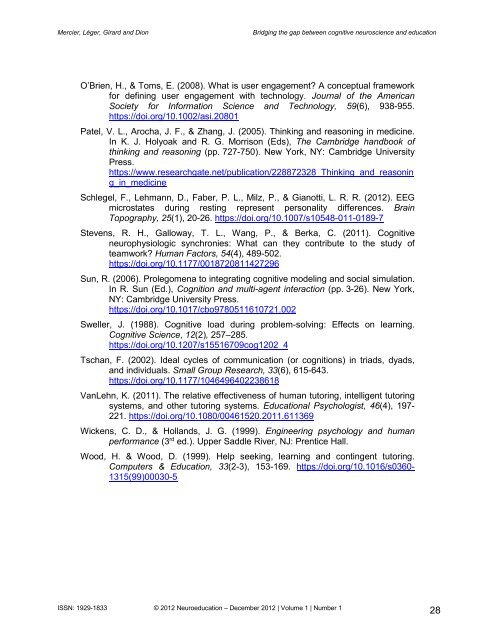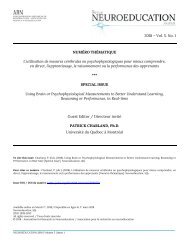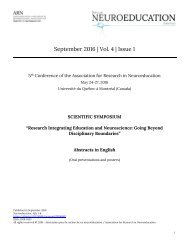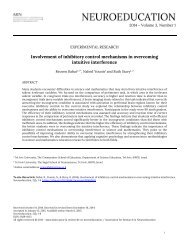Neuroeducation_2012_vol-1_no-1_full
Neuroeducation journal - Volume 1, Issue 1 (2012) - 144 pages
Neuroeducation journal - Volume 1, Issue 1 (2012) - 144 pages
Create successful ePaper yourself
Turn your PDF publications into a flip-book with our unique Google optimized e-Paper software.
Mercier, Léger, Girard and Dion<br />
Bridging the gap between cognitive neuroscience and education<br />
O’Brien, H., & Toms, E. (2008). What is user engagement? A conceptual framework<br />
for defining user engagement with tech<strong>no</strong>logy. Journal of the American<br />
Society for Information Science and Tech<strong>no</strong>logy, 59(6), 938-955.<br />
https://doi.org/10.1002/asi.20801<br />
Patel, V. L., Arocha, J. F., & Zhang, J. (2005). Thinking and reasoning in medicine.<br />
In K. J. Holyoak and R. G. Morrison (Eds), The Cambridge handbook of<br />
thinking and reasoning (pp. 727-750). New York, NY: Cambridge University<br />
Press.<br />
https://www.researchgate.net/publication/228872328_Thinking_and_reasonin<br />
g_in_medicine<br />
Schlegel, F., Lehmann, D., Faber, P. L., Milz, P., & Gia<strong>no</strong>tti, L. R. R. (<strong>2012</strong>). EEG<br />
microstates during resting represent personality differences. Brain<br />
Topography, 25(1), 20-26. https://doi.org/10.1007/s10548-011-0189-7<br />
Stevens, R. H., Galloway, T. L., Wang, P., & Berka, C. (2011). Cognitive<br />
neurophysiologic synchronies: What can they contribute to the study of<br />
teamwork? Human Factors, 54(4), 489-502.<br />
https://doi.org/10.1177/0018720811427296<br />
Sun, R. (2006). Prolegomena to integrating cognitive modeling and social simulation.<br />
In R. Sun (Ed.), Cognition and multi-agent interaction (pp. 3-26). New York,<br />
NY: Cambridge University Press.<br />
https://doi.org/10.1017/cbo9780511610721.002<br />
Sweller, J. (1988). Cognitive load during problem-solving: Effects on learning.<br />
Cognitive Science, 12(2), 257–285.<br />
https://doi.org/10.1207/s15516709cog1202_4<br />
Tschan, F. (2002). Ideal cycles of communication (or cognitions) in triads, dyads,<br />
and individuals. Small Group Research, 33(6), 615-643.<br />
https://doi.org/10.1177/1046496402238618<br />
VanLehn, K. (2011). The relative effectiveness of human tutoring, intelligent tutoring<br />
systems, and other tutoring systems. Educational Psychologist, 46(4), 197-<br />
221. https://doi.org/10.1080/00461520.2011.611369<br />
Wickens, C. D., & Hollands, J. G. (1999). Engineering psychology and human<br />
performance (3 rd ed.). Upper Saddle River, NJ: Prentice Hall.<br />
Wood, H. & Wood, D. (1999). Help seeking, learning and contingent tutoring.<br />
Computers & Education, 33(2-3), 153-169. https://doi.org/10.1016/s0360-<br />
1315(99)00030-5<br />
ISSN: 1929-1833 © <strong>2012</strong> <strong>Neuroeducation</strong> – December <strong>2012</strong> | Volume 1 | Number 1<br />
28








